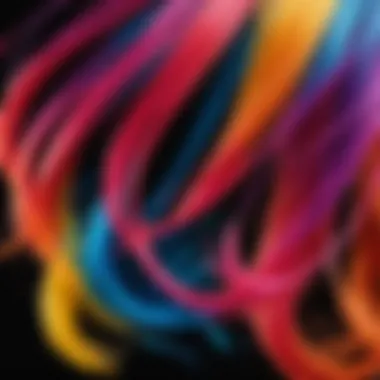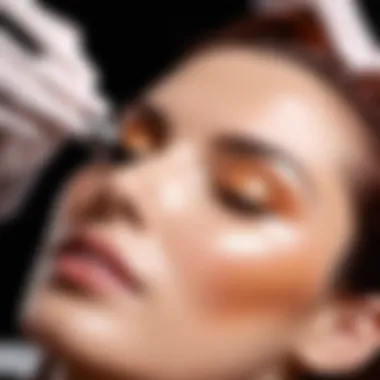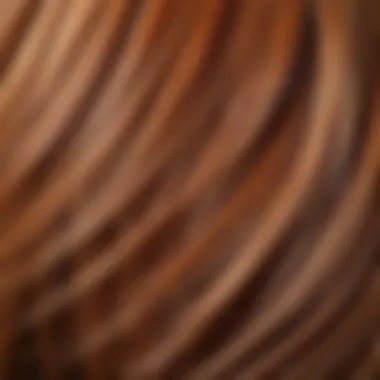Effective Techniques to Remove Hair Dye Safely


Intro
Hair dyeing is a common practice for both aesthetic and personal expression. Many individuals change their hair color frequently, but sometimes, the choice of color or the application method may not yield the desired result. Removing hair dye effectively can be a critical consideration for those looking to return to their natural color or try a new look. This article explores various methods, both home-based and professional, to remove unwanted hair dye, focusing on their effectiveness and impact on hair health.
Ürün İncelemesi
Ürün Tanıtımı
When considering reducing or removing hair dye, product selection is vital. Many commercial products are designed to strip hair color. Popular items include Color Oops, which gently removes unwanted dye while aiming to maintain hair integrity. Other notable brands like Joico Color Intensity Eraser and L'oreal Colorista Fader have garnered attention for their effectiveness.
Ürün Özellikleri
- Color Oops: Formulated to remove color while conditioning hair. Does not lighten hair or bleach it, but rather aims to reverse color molecules.
- Joico Color Intensity Eraser: A professional-grade product that helps to remove direct dye from the hair without excessive damage.
- L'oreal Colorista Fader: Designed for temporary hair colors, it gradually washes away the pigment over multiple applications.
These products usually contain specific ingredients that help to break down the dye molecules without severely affecting the hair's natural structure.
Güzellik İpuçları
Doğal Güzellik Yöntemleri
Some individuals prefer natural remedies. Common home methods include:
- Baking Soda: Mixed with shampoo, it can help lift color. It may require repeated applications for effectiveness.
- Vitamin C: Crushed tablets mixed with shampoo can effectively reduce color intensity.
- Dish Soap: Contains stronger detergents compared to regular shampoo, making it effective for temporary or semi-permanent colors.
These methods offer a more gentle approach and can be more accessible for those who prefer minimal chemical exposure.
Sağlıklı Beslenme ve Güzellik
Eating a balanced diet can support overall hair health, which is essential when frequently altering hair color. Focus on:
- Vitamins: Vitamin E, Biotin, and B vitamins promote hair strength and appearance.
- Omega-3 Fatty Acids: Found in fish, walnuts, and seeds; they help in maintaining scalp health.
- Hydration: Proper water intake is critical for hair's moisture levels.
Consideration of nutrient intake highlights the holistic relationship between diet and hair care.
"Proper care and informed choices are crucial for maintaining your hair’s health during dye removal."
By understanding the available products and methods, individuals can make informed decisions that align with their beauty needs and hair care routines.
Preamble
The removal of hair dye is a topic of practical importance for many individuals. As dye choices become increasingly varied, understanding how to effectively eliminate unwanted color from hair is essential. Hair dye removal not only addresses aesthetic concerns but also impacts hair health.
There are numerous factors to consider when approaching hair dye removal. The type of dye used, duration of application, and condition of the hair all influence the effectiveness of removal methods. Given the potential for damage during this process, knowledge about safe and effective techniques is crucial.
Furthermore, comprehending the underlying chemistry of hair dye provides insights into the methods that can be employed. Different dye types will respond differently to various removal strategies, illustrating the need for a tailored approach.
In summary, this section lays the groundwork for understanding the complexities involved in hair dye removal. It emphasizes that informed decisions can lead to successful outcomes, thereby enhancing one’s hair care routine.
Determining the Type of Hair Dye


Identifying the specific type of hair dye used is crucial in the process of removal. Different dyes interact with hair differently, influencing the methods required to effectively eliminate them without causing excessive damage. Understanding these categories helps in choosing the right approach, which ensures hair health and safety during the removal process.
Temporary Hair Dyes
Temporary hair dyes are designed for short-term use. They typically coat the surface of the hair shaft and can be washed out within a few shampoos. This makes them favorable for those who want to try a new color without a long commitment.
The main characteristic of temporary dyes is that they generally do not penetrate the hair structure. Thus, most times, washing with a gentle shampoo can effectively remove the color. However, if a buildup occurs, a clarifying shampoo may be needed for a thorough cleanse. Keep in mind that even gentler formulations can sometimes strip protective oils from hair, thus hydration after usage is always crucial.
Some common brands that carry temporary hair dyes include Manic Panic and L’Oreal Colorista.
Semi-Permanent Dyes
Semi-permanent dyes offer a compromise between durability and ease of removal. These products typically last longer than temporary dyes, often remaining in the hair for several weeks.
Semi-permanent dyes penetrate the outer layer of the hair but do not alter the natural pigment permanently. To remove them, multiple washes with a regular shampoo can help, although this process may take more time. Additionally, methods such as using a mixture of baking soda and shampoo have shown success in lightening the color faster. When using such treatments, be cautious of hair dehydration and always follow up with a good conditioner or moisturizing mask.
Common brands known for semi-permanent dyes include Clairol Natural Instincts and Wella Color Charm.
Permanent Hair Dyes
Permanent dyes are the most challenging to remove. They are designed to chemically alter the hair’s structure, providing long-lasting color that can endure numerous washes. The pigments in these dyes fully penetrate the hair, which means simply washing won’t suffice in removing them.
To effectively remove permanent hair dye, specialized color removers or bleaching agents may be necessary. Color removers work by breaking down the dye's molecules, allowing for easier extraction from the hair. Bleaching, although harsher, can lighten the hair significantly. However, it can also lead to severe damage if not applied properly or if done excessively.
Options like Color Oops or B4 are typical brands for color removers, while bleaching products can be found in brands like Schwartzkopf and Wella.
Identifying the type of dye used is essential in planning the best removal strategy. Each type has its own set of characteristics that require different approaches to ensure the hair remains healthy and manageable.
Home Remedies for Dye Removal
Home remedies for dye removal present a viable alternative for those looking to eliminate unwanted hair color. These methods are often cost-effective, easily accessible, and may utilize ingredients that are already found in the home. Using home remedies can also be less damaging to the hair compared to harsh chemicals. However, they require patience and a willingness to experiment to find the right solution that works for individual hair types and dye products.
Baking Soda Solutions
Baking soda is well-known for its versatile uses, including its role in removing hair dye. This natural abrasive can help lift color from the hair while also acting as a gentle exfoliant. To use this method, mixing baking soda with shampoo is a common approach. The texture of baking soda aids in stripping away dye without overly drying the hair.
To create a simple baking soda solution, combine one part baking soda with three parts of a clarifying shampoo. Apply this mixture to wet hair, focusing on areas with the most dye buildup. Leave it on for about 10-15 minutes before rinsing thoroughly. Some users report noticeable results after just a few treatments, although it’s essential to monitor hair condition throughout the process.
Vitamin Treatments
Vitamin C is another effective ingredient for hair dye removal. It works chemically by breaking down the dye molecules, making them easier to wash away. This method is particularly useful for those with semi-permanent hair dyes. To utilize this remedy, crush several Vitamin C tablets and mix them with a mild shampoo to create a paste.
Apply the paste to damp hair, ensuring even coverage. Cover the hair with a shower cap to facilitate the process, as heat can enhance the efficacy of the treatment. Leave it on for 30-60 minutes, and then rinse thoroughly. Though results may vary, many find that this method significantly lightens their hair color, providing a satisfactory outcome.
Clarifying Shampoos
Clarifying shampoos are specifically formulated to remove product buildup, including hair dye. These products contain stronger cleansing agents than standard shampoos, making them effective for dye removal. When using a clarifying shampoo, it’s advisable to follow the instructions on the bottle to avoid excessive drying of the hair.
For best results, apply the clarifying shampoo to wet hair and massage it in thoroughly for a few minutes before rinsing. Repeat this process as needed, but it’s important to limit use to prevent damage to the hair. While clarifying shampoos are generally effective, combining them with other home remedies can enhance their dye-removal potential.


Chemical Solutions for Hair Dye Removal
Chemical solutions for hair dye removal play a vital role in effectively eliminating unwanted colors from the hair. These options are particularly useful when home remedies do not deliver the desired results. Understanding them allows individuals to make informed choices that balance effectiveness with the health of their hair. Chemical solutions can penetrate the hair shaft more deeply than most home remedies, offering a more immediate and noticeable impact. However, they require careful consideration, as they can also strip away natural oils and moisture, potentially leading to damage or dryness. Hence, knowing the specifics about each chemical solution is crucial for achieving optimal results without compromising hair health.
Color Removers
Color removers are specialized products designed to strip away unwanted hair dye. These products often contain specific agents that break down the dye within the hair, making it easier to wash away. The effectiveness of color removers varies, depending on factors such as the type of dye initially used and the condition of the hair.
- Key Benefits
Color removers can effectively reverse the effects of hair dye, especially semi-permanent and permanent types. They can facilitate the transition to a different color or return to a more natural shade. - Considerations
While using color removers, it's imperative to conduct a patch test. This ensures there is no adverse reaction to the chemicals involved. Moreover, color removers may have strong odors and can still affect hair quality. Following the application, a deep conditioning treatment is advisable to replenish moisture.
Bleaching Agents
Bleaching agents are another chemical solution often used to lighten or remove hair dye. Unlike color removers, which target specific dye molecules, bleaching agents act by stripping the color from the hair entirely. This method can be particularly effective for darker shades.
- Key Benefits
The primary advantage of bleaching is its ability to lift color more drastically and efficiently for those aiming to achieve a lighter base tone before attempting a new color. It can be a good option for individuals who want significant color changes. - Considerations
Using bleaching agents requires prudence. They can cause significant damage if the hair is already compromised. Over-bleaching may lead to severe dryness and breakage. It is crucial to perform a strand test prior to use. Additionally, after using bleach, hair should be treated with restorative products to help rebuild strength and moisture.
"When contemplating chemical solutions, always prioritize hair health alongside the desire for color change."
Overall, both color removers and bleaching agents serve as powerful tools in the hair dye removal arsenal. They offer a way to reclaim one’s natural color or explore new shades, balancing effectiveness with necessary care.
Professional Treatments
Professional treatments play a crucial role when addressing unwanted hair dye. While at-home methods can be effective, salon professionals have access to advanced techniques and products that might not be available for home use. Additionally, the training and experience these specialists possess help ensure better outcomes while minimizing the risk of damage to the hair.
When considering professional treatments, it is essential to understand different options available and the benefits they provide. Salon services often include specialized colour removers and targeted conditioning treatments designed to restore the hair’s natural luster. Hair professionals can assess the condition of the hair and customize their approach, which is critical for evaluating the damage from past dyes and determining the best course of action.
Salon Services
Salon services for dye removal can vary significantly. Many salons offer color-removing treatments that effectively strip away the unwanted dye. These services might include:
- Color Removers: Products designed specifically to remove artificial hair color without altering the natural pigment of the hair.
- Bleaching Services: When necessary, professional bleaching can lighten the hair enough to remove residual dye, although it carries a higher risk of damage.
Moreover, professionals often use deep conditioning treatments during or after dye removal to help mitigate damage. This combination ensures that while the hair color is changed, the integrity of the hair is preserved as much as possible.
Consulting with a Hair Specialist
Consulting with a hair specialist is an important step before undergoing any treatment. A specialist can provide insights based on their analysis of your hair type and history. They will assess the products previously used and the overall condition of your hair.
During a consultation, consider discussing the following:
- Hair History: Provide information about previous dyes and treatments. This data is vital for the specialist to plan an appropriate solution.
- Desired Outcome: Be clear about what you aim to achieve. Whether you want to return to your natural color or achieve a specific look, articulate your goals clearly.
- Possible Risks: Every treatment has risks. A knowledgeable specialist can outline these and suggest the best methods to minimize them.
In summary, professional treatments and consultations with hair specialists are essential for achieving the best results in hair dye removal. The expertise and resources available in a salon setting can lead to effective, safe outcomes that at-home methods might not match.
"Sometimes, professional help can be the difference between healthy hair and damaged strands. Always consult first!"
Post-Dye Removal Hair Care
After removing hair dye, it is crucial to focus on post-dye care. Hair often becomes dry and fragile due to the chemicals involved in dyeing, regardless of the removal method used. Neglecting hair after dye removal can lead to further damage, breakage, and an overall unhealthy appearance. Therefore, incorporating effective care practices not only protects the strands but also helps restore hair health, shine, and manageability. This section will discuss two critical aspects of post-dye removal hair care: hydration and nutrition, and the use of repairing products.


Hydration and Nutrition
Proper hydration is essential for maintaining healthy hair, particularly after it has been subjected to harsh dye and removal processes. Water helps in the overall functioning of the body’s systems, including hair health. Here are some important points to consider regarding hydration and nutrition:
- Drinking Water: Aim to drink an adequate amount of water daily. This helps keep hair hydrated from within. Dehydrated hair often becomes brittle and more prone to damage.
- Nutrient-Rich Diet: Foods rich in vitamins and minerals significantly contribute to hair health. Incorporate foods high in omega-3 fatty acids such as salmon, and antioxidants found in berries and greens. These nutrients can assist in restoring hair's natural strength and elasticity.
- Protein Intake: Hair is primarily composed of protein. Ensuring sufficient protein in your diet is vital for hair regeneration. Consider foods such as eggs, nuts, and legumes.
Hydration and nutrition can improve hair’s texture and resilience, making it easier to style and manage post-dye.
Using Repairing Products
After dye removal, using the right repairing products is equally vital. These products facilitate recovery and rejuvenate damaged hair. Consider the following when selecting repairing hair care products:
- Deep Conditioners: Look for deep conditioning treatments that contain hydrating ingredients like shea butter or argan oil. These can help restore moisture balance to the hair and promote softness.
- Leave-In Treatments: Leave-in conditioners assist in maintaining moisture levels and can also reduce frizz. Products formulated for damage repair can enhance shine and protect hair from environmental stresses.
- Hair Masks: Weekly hair masks specially designed to repair and nourish can greatly benefit hair after dyeing. Seek products with proteins to strengthen the hair structure and prevent breakage.
Overall, prioritizing hydration and utilizing repairing products allow for better results following dye removal. A consistent post-dye care routine can facilitate healthier, stronger hair, addressing any damage caused during the dyeing process.
Prevention of Hair Dye Issues
When it comes to maintaining the health and integrity of your hair, preventive measures prior to dyeing can be significantly effective. Understanding the importance of prevention leads to better outcomes and minimizes the risks associated with hair dyeing. Many issues related to hair dye stem from improper techniques or failure to identify potential allergic reactions. It is crucial to embrace specific practices to avoid adverse effects such as hair damage, unwanted color results, or skin sensitivities.
Patch Testing Before Dyeing
Conducting a patch test prior to dyeing is an essential step. This practice helps to determine whether you might have an allergic reaction to the dye. The complexity of hair dye formulations means they can contain various chemicals. Some people may experience allergic reactions when these chemicals come into contact with their skin.
To perform a patch test, follow these steps:
- Select a small area: Choose a discrete area of skin, usually behind the ear or on the inner elbow.
- Apply the dye: Use a small amount of the hair dye to apply a thin layer on the selected area.
- Wait for 48 hours: Observe the area for 48 hours. If redness, itching, or swelling occurs, do not use that dye.
Patch testing reduces the risk of severe allergic reactions and enhances your safety while applying hair color.
Proper Application Techniques
Using proper application techniques is vital when applying hair dye. The aim is to achieve even coloring while minimizing damage to the hair and scalp. Here are several key considerations:
- Section Your Hair: Divide your hair into manageable sections. This makes it easier to apply dye uniformly.
- Use the Right Tools: Employ a dye brush and bowl for precise applications. Gloves are necessary to protect your hands from staining.
- Follow Instructions: Always read and adhere to the manufacturer's instructions on the dye packaging to ensure accurate mixing and timing.
- Apply the Dye Evenly: Start from the roots and apply the dye downwards, ensuring full coverage. This technique is particularly useful for achieving uniform color results.
- Monitor Timing: Do not exceed the suggested application time. Leaving dye on for too long can lead to over-processing and damage.
By implementing these application techniques, you can ensure that the dye works effectively and reduces the likelihood of mishaps.
"Prevention is better than cure. A proactive approach to hair dyeing can save your hair from future damage."
Emphasizing prevention and proper technique establishes a foundation for successful hair dyeing. Taking these steps can lead to positive experiences and beautiful results.
Culmination
The conclusion serves as a crucial element in effectively summarizing the content presented in this article. It encapsulates the main points related to hair dye removal techniques, reaffirms the importance of taking a thoughtful approach to choosing the right method, and highlights best practices for maintaining hair health. By synthesizing the previously discussed methods—ranging from home remedies to professional treatments—readers can appreciate the various options available to them.
Additionally, a focus on post-dye care cannot be overstated. It is essential to consider hydration and nutrition as integral parts of the hair dye process. This awareness encourages individuals to prioritize not just removal but the overall health of their hair throughout the dyeing journey.
Summarizing Key Takeaways
- Understanding of Dye Types: Recognizing the differences between temporary, semi-permanent, and permanent dyes informs the choice of removal method. Each type has its own characteristics and challenges concerning how to effectively remove it.
- Home Remedies vs. Chemical Solutions: The article outlines various options available, such as baking soda solutions and color removers, aiding in the decision-making process.
- Professional Help: Consulting a hair specialist or seeking salon services can provide clarity and efficiency in achieving desired results. Professional insight can prevent potential damage.
- Post-Dye Care: Emphasis on hydration, nutrition, and the use of repairing products is essential for maintaining healthy hair post-dye removal.
Future Perspectives on Hair Care
As the beauty industry evolves, there is a growing emphasis on personalization in hair care. Future advancements will likely focus on products that cater to specific hair types and needs, addressing both aesthetic preferences and health considerations.
Furthermore, sustainable practices in hair dyeing and removal may gain ground. Consumers are becoming increasingly aware of the environmental impact of beauty products. Brands that prioritize eco-friendly ingredients and formulations are more likely to resonate with future generations. In summary, ongoing education about hair care and dye removal will empower individuals to make informed decisions, ensuring their hair health remains a priority.







